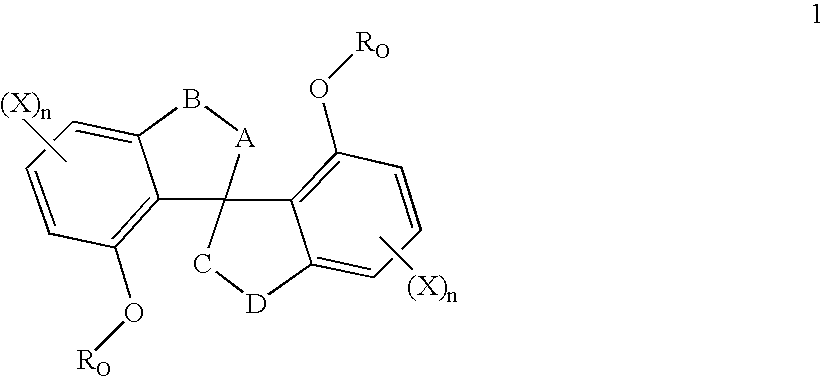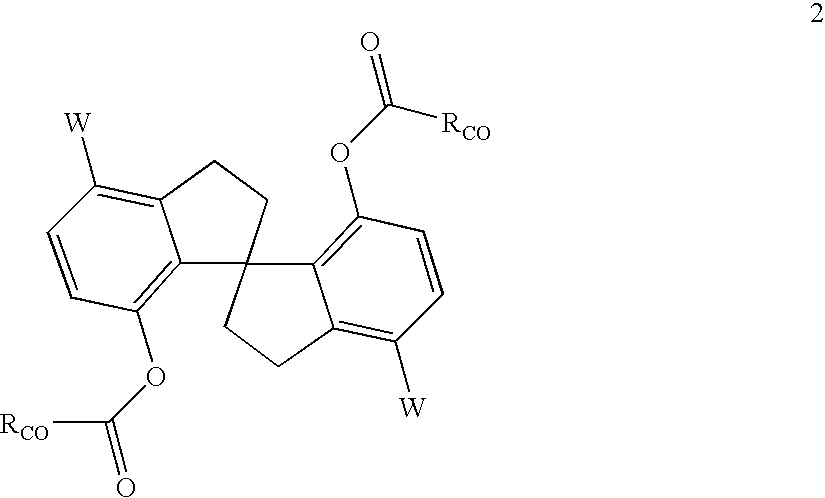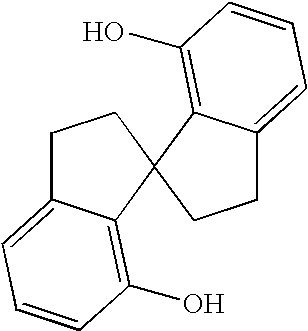Chiral compounds and compositions containing the same
a technology of chiral compounds and compositions, applied in the field of chiral nematic liquid crystal formation, can solve the problems of increasing the pitch of the resulting chiral nematic formulation, and limitations in dopant utility
- Summary
- Abstract
- Description
- Claims
- Application Information
AI Technical Summary
Benefits of technology
Problems solved by technology
Method used
Image
Examples
example 1
[0044]Several enantiomerically pure derivatives of the invention were prepared (vide supra) and known amounts of these compounds combined with the commercially available liquid crystalline compound 4-n-pentyl-4′-cyanobiphenyl, 5CB, having the following structure:
[0045]
[0046]The mixture was heated above its clearing point, thoroughly mixed and allowed to cool to ambient temperature. The pitches of these samples were then measured either from standard reflectance response curves or by the method of Dogic and Fraden (vide supra). The HTP's (β) of these samples, on a mole fraction basis, were then calculated as described above. Results of this experiment are found in Table 1 showing the HTP's in 5CB at ambient temperatures.
[0047]
TABLE 1CompoundR7 / R7′*β (μm)−1I-2153I-3153I-4170I-5200I-6238I-7200I-8295*Unless otherwise indicated R7 and R7′ are the same substituent.
example 2
[0048]Several enantiomerically pure derivatives of the invention were prepared (vide supra) and known amounts of these compounds combined with the commercially available liquid crystalline mixture BL087 (described as a mixture of 5CB (25–40%), the structurally related 2CB wherein the n-pentyl group is replaced by an ethyl group (10–25%), and a proprietary LC mixture (35–65%)) available from Merck KGaA, Darmstadt, Germany. The mixture was heated above its clearing point, thoroughly mixed and allowed to cool to ambient temperature. The pitches of these samples were then measured either from standard reflectance response curves or by the method of Dogic and Fraden (vide supra). The HTP (β) of these samples was then calculated as described above, except on a weight percent basis. Results of this experiment are found in Table 2 below showing HTP's in 5CB at ambient temperatures.
[0049]
TABLE 2β (μm)−1CompoundR7 / R7′*(wt. %)−1I-1 0.03I-2 0.72I-3 0.72I-4 0.59I-5 0.75I-6 0.75I-7 0.84I-8 0.61I-...
example 3
[0050]Several enantiomerically pure derivatives of the invention were prepared (vide supra) and known amounts of these compounds combined with the commercially available liquid crystalline compound MBBA having the following structure:
[0051]
[0052]The mixture was heated above its clearing point, thoroughly mixed and allowed to cool to ambient temperature. The pitches of these samples were then measured either from standard reflectance response curves or by the method of Dogic and Fraden (vide supra). The HTP (β) of these samples was then calculated, on a mole fraction basis, as described above. Results of this experiment are found in Table 3 below showing HTP's in MBBA at ambient temperatures.
[0053]
TABLE 3CompoundR7 / R7′*β (μm)−1I-5156I-6237I-7155I-8238*Unless otherwise indicated R7 and R7′ are the same substituent.
PUM
| Property | Measurement | Unit |
|---|---|---|
| structure | aaaaa | aaaaa |
| liquid crystalline | aaaaa | aaaaa |
| ferroelectric | aaaaa | aaaaa |
Abstract
Description
Claims
Application Information
 Login to View More
Login to View More - R&D
- Intellectual Property
- Life Sciences
- Materials
- Tech Scout
- Unparalleled Data Quality
- Higher Quality Content
- 60% Fewer Hallucinations
Browse by: Latest US Patents, China's latest patents, Technical Efficacy Thesaurus, Application Domain, Technology Topic, Popular Technical Reports.
© 2025 PatSnap. All rights reserved.Legal|Privacy policy|Modern Slavery Act Transparency Statement|Sitemap|About US| Contact US: help@patsnap.com



